Did Edge Cts2 Ever Get Oil Pressure Readings
The deepest pigsty we take e'er dug
(Image credit:
Getty Images
)
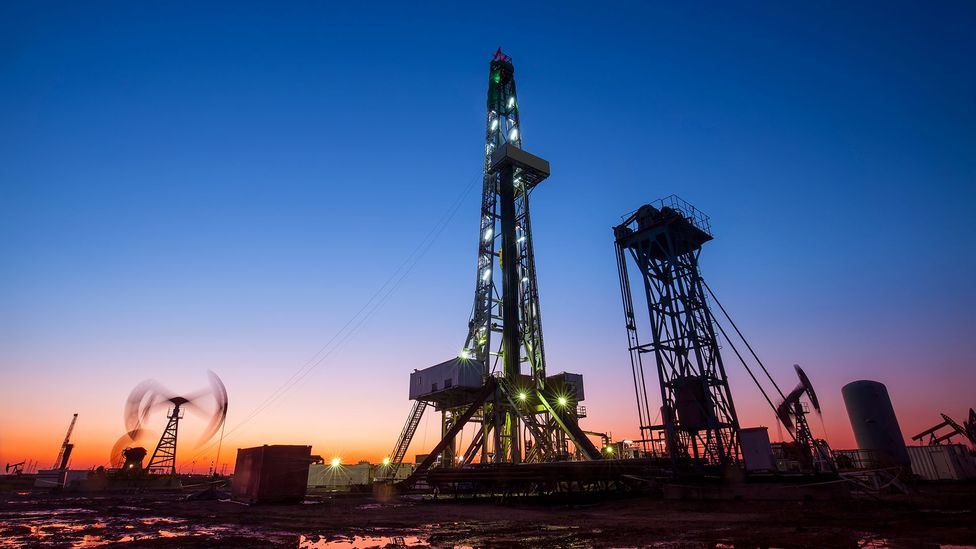
During the Cold War, the U.s.a. and Soviets both created ambitious projects to drill deeper than e'er earlier.
* This story is featured in BBC Future's "Best of 2019" drove. Discover more than of our picks.
The lakes, forests, mists and snow of the Kola Peninsula, deep in the Arctic Circle, can make this corner of Russia seem like a scene from a fairy tale. Yet amidst the natural dazzler stand the ruins of an abandoned Soviet scientific inquiry station. In the center of the crumbling building is a heavy, rusty metal cap embedded in the concrete floor, secured by a ring of thick and equally rusty metal bolts.
According to some, this is the entrance to hell.
This is the Kola Superdeep Borehole, the deepest manmade hole on Earth and deepest bogus betoken on Earth. The 40,230ft-deep (12.2km) construction is so deep that locals swear y'all tin hear the screams of souls tortured in hell. It took the Soviets almost 20 years to drill this far, but the drill bit was notwithstanding merely nigh 1-third of the mode through the crust to the Earth's mantle when the project came grinding to a halt in the chaos of post-Soviet Russian federation.
The Soviets' superdeep borehole isn't alone. During the Cold War, there was a race past the superpowers to drill as deep as possible into the Earth's crust – and even to attain the mantle of the planet itself.
Now the Japanese want to have a go.
You might also like:
- The ghostly radio station no-one claims to run
- What was it like to work in the world'south biggest building
- The giant hangar congenital for an Chill airship
"It was in the time of the Atomic number 26 Curtain when the drilling was started," says Uli Harms of the International Continental Scientific Drilling Program, who as a young scientist worked on the High german rival to the Kola borehole. "And there was certainly competition between u.s.. One of the main motivations was that the Russians were merely non really open with their information.
"When the Russians started to drill they claimed they had institute free h2o – and that was but not believed by most scientists. In that location used to be common understanding among Western scientists that the crust was so dense 5km downward that h2o could not permeate through information technology."
"The ultimate goal of the [new] project is to get bodily living samples of the mantle as it exists correct now," says Sean Toczko, plan manager for the Nihon Bureau for Marine-Earth Science. "In places similar Oman you lot can find mantle close to the surface, but that'south mantle as it was millions of years ago.
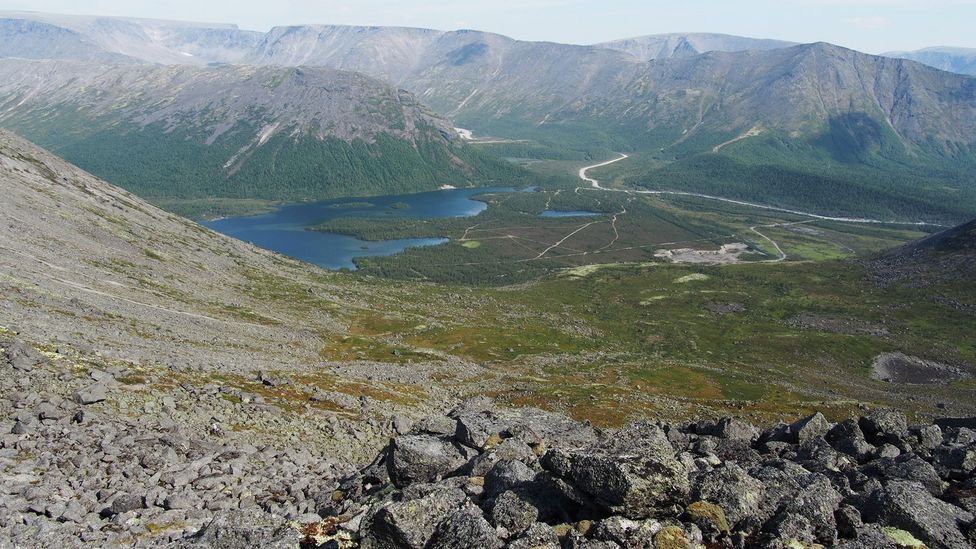
The borehole is located in the wilds of Russia's northern Kola Peninsula (Credit: Getty Images)
"It's the deviation between having a live dinosaur and a fossilised dinosaur bone."
If the Earth is similar an onion, then the crust is like the thin skin of the planet. It is only 25 (40km) miles thick. Beyond this, is the 1,800-mile deep pall and beyond that, right at the center of the Earth, is the core.
Like the space race, the race to the explore this unknown "deep frontier" was a demonstration of engineering prowess, cut-edge applied science and the "right stuff". The scientists were going where no human had gone earlier. The rock samples these super-deep boreholes could supply were potentially as important for science equally anything Nasa brought back from the moon. The simply difference was that this time the Americans didn't win the race. In fact, no-one really did. (Read nearly how a switch saved the race to the Moon from disaster.)
The US had fired up the first drill in the race to explore the deep frontier. In the late 1950s, the wonderfully named American Miscellaneous Society came up with the first serious programme to drill down to the mantle. The society-turned-drinking-society was an informal group made up of the leading lights of the US scientific customs. Their crack at drilling through the World's crust to the drapery was called Project Mohole, named after the Mohorovičić discontinuity, which separates the crust from the mantle.
Rather than drill a very, very deep hole, the US trek – observed by novelist John Steinbeck – decided to accept a curt cut through the Pacific Ocean floor off Guadalupe, Mexico.
The reward of drilling through the bounding main floor is that the Earth's crust is thinner there; the disadvantage is that the thinnest areas of crust is usually where the ocean is at its deepest.
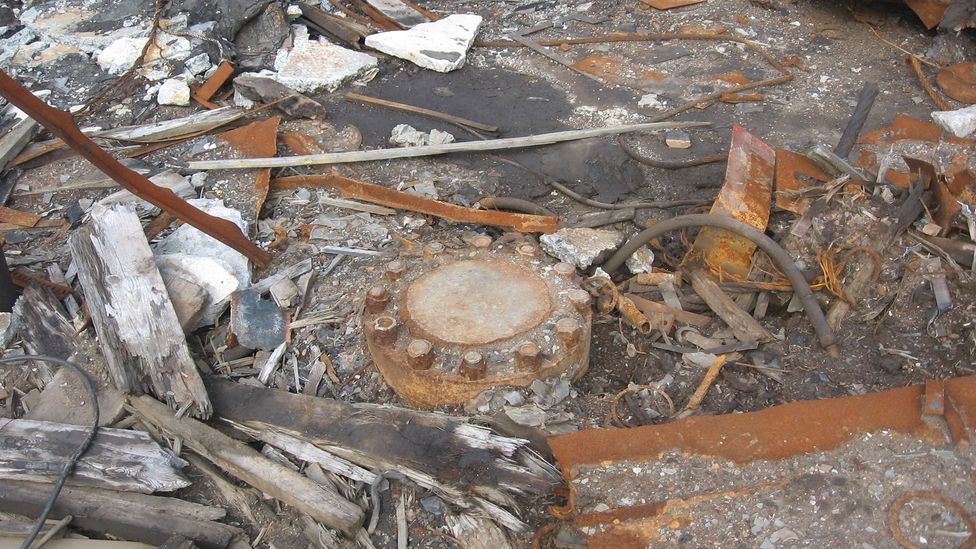
The borehole still exists - but the entrance has been welded shut (Credit: Rakot13/CC BY-SA 3.0)
The Soviets started to drill in the Chill Circle in 1970. And finally, in 1990, the German Continental Deep Drilling Plan (KTB) began in Bavaria – and eventually drilled downwards to 5.6 miles (9km).
Every bit with the mission to the Moon, the trouble was that the technologies needed for the success of these expeditions had to be invented from scratch.
When in 1961 Projection Mohole began to drill into the seabed, deep-sea drilling for oil and gas was still far off. No 1 had yet invented now essential technologies such as dynamic positioning, which allows a drill send to stay in its position over the well. Instead, the engineers had to improvise. They installed a system of propellers forth the sides of their drill ship to keep it steady over the hole.
1 of the biggest challenges the High german engineers faced was the need to drill a pigsty that is as vertical as possible. The solution they came up with is now a standard technology in the oil and gas fields of the world.
"What was clear for the feel of the Russians was that y'all take to drill as vertical equally possible because otherwise you increase torque on the drills and kinks in the hole," says Uli Harms. "The solution was to develop vertical drilling systems. These are now an industry standard, just they were originally adult for KTB – and they worked until 7.5kms (four.7 miles). Then for the terminal 1.5–2km (.9 to one.25 miles) the pigsty was off the vertical line for almost 200m.
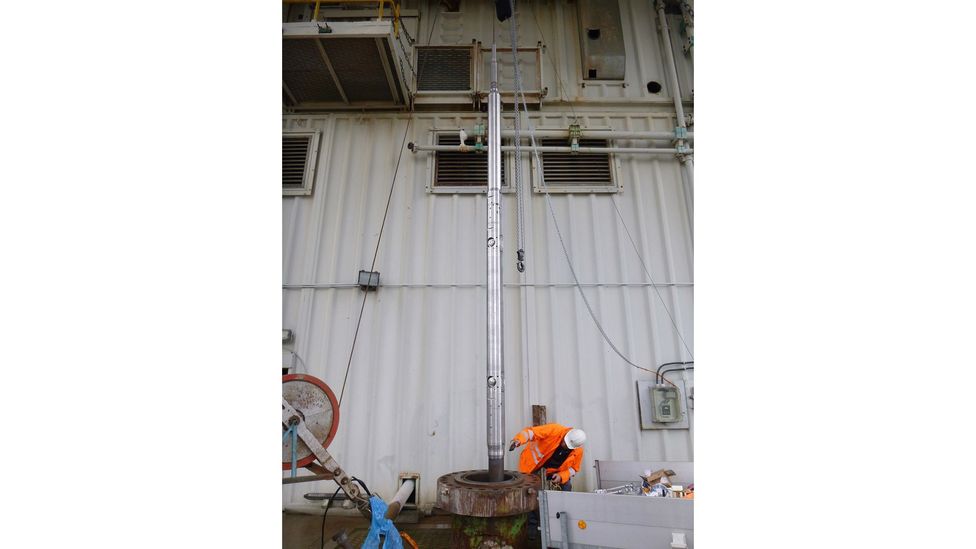
The Germans began their own superdeep borehole project in 1990 (Credit: Jochem Kueck)
"We tried to utilize some of the Russian techniques in the early on 90s or late 80s when Russia became more than open and willing to cooperate with the West," he adds. "Unfortunately, it was non possible to go the equipment in fourth dimension."
However, all of these expeditions ended in a degree of frustration. In that location were false start and blockages. Then in that location were the high temperatures their machinery encountered that deep secret, the cost and the politics – all of which put paid to the dreams of the scientists to drill deeper, and suspension the record for the deepest hole.
Two years before Neil Armstrong walked on the moon, U.s.a. Congress cancelled the funding for Projection Mohole when costs began to spiral out of control. The few metres of basalt that they were able to bring upwards worked out at a cost of roughly $40m (£31m) in today's coin.
Then it was the turn of the Kola Superdeep Borehole. Drilling was stopped in 1992, when the temperature reached 180C (356F). This was twice what was expected at that depth and drilling deeper was no longer possible. Following the collapse of the Soviet Union there was no money to fund such projects – and three years afterward the whole facility was closed down. Now the desolate site is a destination for adventurous tourists.
The German borehole has been spared the fate of the others. The huge drill rig is still there – and a tourist attraction today – but today the crane just lowers instruments for measurement. The site has become in effect an observatory of the planet – or even an art gallery.
When Dutch artist Lotte Geevan lowered her microphone protected past a thermal shield down the German borehole, it picked upward a deep rumbling sound that scientists couldn't explicate, a rumbling that made her "feel very small-scale; it was the get-go time in my life this big ball we live on came to life, and information technology sounds haunting," she says. "Some people thought it did audio similar hell. Others thought they could hear the planet exhale."
"The program was there to drill deeper than the Soviets," says Harms, "simply we hadn't fifty-fifty reached our immune phase of 10km (6.25 miles) in the time we had. Then where nosotros were drilling was just much hotter than where the Russians were. It was pretty clear that it was going to be much more difficult for u.s. to become whatsoever deeper.
"By and then information technology was too the early on 90s in Germany and there was no adept statement to heighten additional funding to go whatever deeper because the German unification was costing such a lot of money."
Information technology is difficult not to shake off the feeling that the race to the Earth's drape is an updated version of the famous novel Journey to the Center of the Globe. While the scientists don't expect to notice a hidden cave full of dinosaurs, they do depict their projects equally "expeditions".
"Nosotros thought of it as an expedition because it really took some time in terms of preparation and execution," says Harms, "and because you're really going into no-man's land, where no-one has been before, and that is actually unusual today.
"You always notice downwardly in that location something that really surprises you, and particularly if y'all go down into an area that is very deep in the crust.
"And if we talk about KTB or the Kola Superdeep, and then the theories that were backside the goals of the project were 30–xl years erstwhile by the time drilling started."
"The matter about these missions is that they are like planetary exploration," says Damon Teagle, professor of geochemistry in the School of Sea and Globe Science, National Oceanography Centre Southampton at the University of Southampton, who has been heavily involved in the new Japanese-led project. "They are pure science undertakings and you never know quite know what you are going to detect.
"At Hole 1256 [a hole drilled by the Deep Body of water Drilling Project (DSDP) and Body of water Drilling Programme (ODP)], nosotros were the get-go get to see intact bounding main crust. No one had got to it before. It was really exciting. There are always surprises."
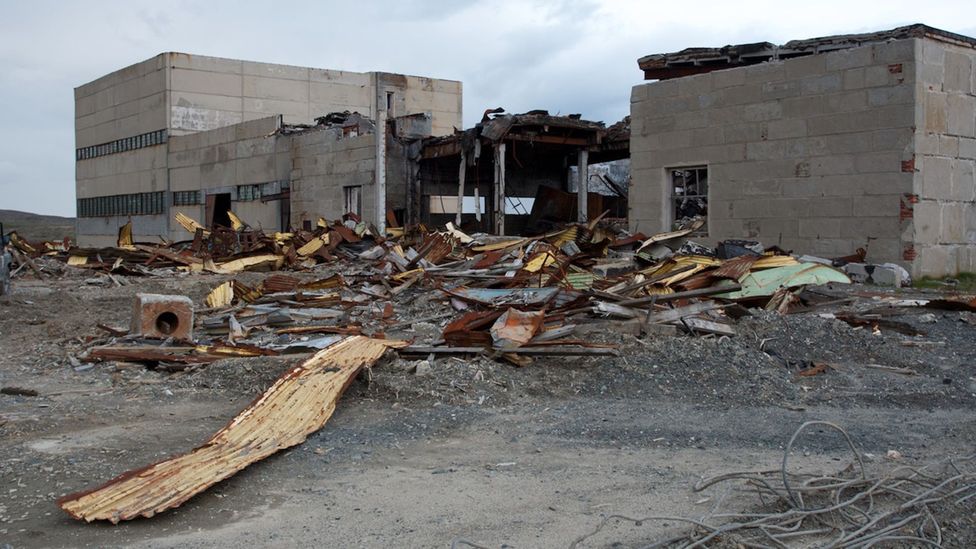
The Kola Super Borehole site has been derelict since the early 1990s (Credit: Rakot13/CC BY-SA 3.0)
Today, "M2M-MoHole to Pall" is one of the most of import projects of the International Ocean Discovery Program (IODP). Equally with the original Project Mohole, the scientists are planning to drill through the seabed where the crust is only about 6km (3.75 miles) deep. The goal of the $1bn (£775m) ultradeep drilling projection is to recover the in-situ curtain rocks for the first fourth dimension in the human history.
"To do this would exist an amazing undertaking and require a huge commitment from Japan," says Teagle, who is involved in the project.
Despite the importance of the projection, the huge drilling ship the Chikyū was built well-nigh xx years agone with this project in mind. The Chikyū uses a GPS system and six adjustable computer-controlled jets that can alter the position of the huge ship by as picayune every bit 50cm (20in).
"The idea is that this ship would choice up the torch and keep the work started by the original Mohole project 50 years ago," says Sean Toczko, plan managing director for the Nihon Agency for Marine-Earth Science. "Superdeep boreholes take made a lot of progress in telling us virtually the thick continental chaff. What nosotros are trying to exercise is find out more about the Crust-Mantle boundary.
"The principal sticking point is that there are three main candidate sites. Ane of those is off Costa Rica, ane off Baha, and one off Hawaii."
Each of the sites involves a compromise betwixt the depth of the ocean, distance from the drilling site and the demand for a base on the shore that tin support a billion-dollar, 24-hours-a-twenty-four hours operation at body of water. "The infrastructure can exist built up, but that takes time and coin," adds Toczko.
"In the end, it really is a cost issue," says Harms. "These expeditions are extremely expensive – and therefore they are difficult to repeat. They tin cost hundreds of millions of euros – and only a pocket-sized percentage will actually be for the earth sciences, the residue volition be for technological development, and of course, operations.
"Nosotros demand inspiring politicians to talk up the value of these expeditions."
--
Join more ane million Hereafter fans by liking us on Facebook , or follow us on Twitter or Instagram .
If y'all liked this story, sign up for the weekly bbc.com features newsletter , called "If You lot Merely Read half dozen Things This Week". A handpicked selection of stories from BBC Future, Culture, Capital, and Travel, delivered to your inbox every Friday.
stapletonexciation91.blogspot.com
Source: https://www.bbc.com/future/article/20190503-the-deepest-hole-we-have-ever-dug
0 Response to "Did Edge Cts2 Ever Get Oil Pressure Readings"
Post a Comment